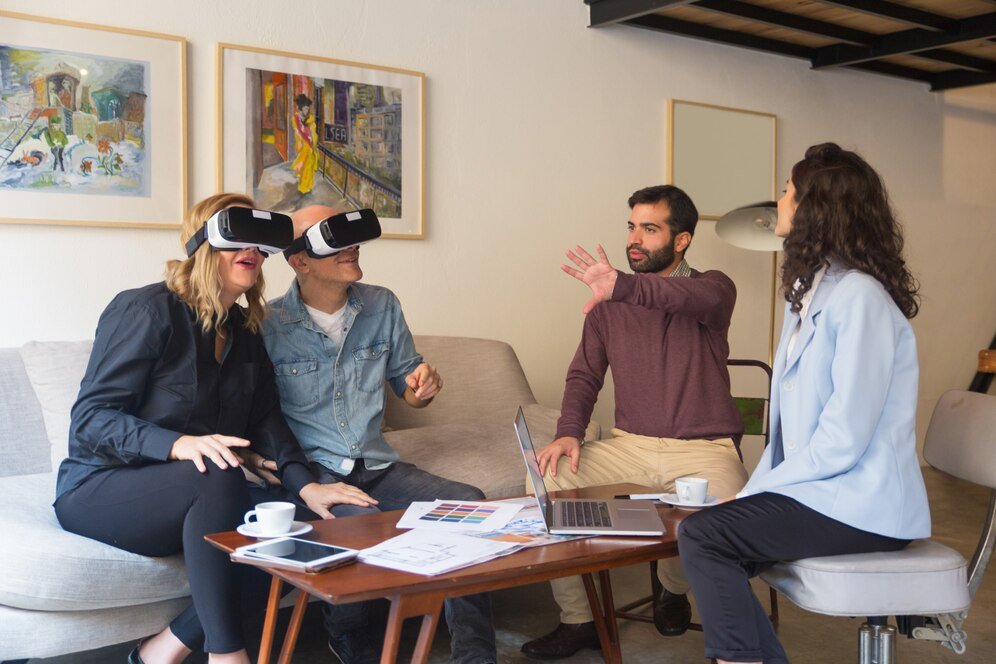Augmented Reality (AR) has become a transformative force in the digital world, blurring the lines between reality and virtual experiences. Initially popularized in gaming and entertainment, AR is now making significant inroads into web development, reshaping how businesses interact with users online. As custom web and app development continues to evolve, AR offers immersive experiences that engage users like never before. This blog explores how AR is revolutionizing web development, its applications across various industries, and the benefits it brings to businesses.
Additionally, we will discuss how companies can leverage mobile application development services and hire remote developers to integrate AR into their digital platforms seamlessly.
The Rise of AR in Web Development
Traditionally, AR experiences were confined to mobile applications. However, with advancements in web technologies like WebXR and WebAR, AR experiences can now be delivered directly through web browsers without requiring users to download an app. This shift has opened new opportunities for businesses looking to enhance user engagement, brand interaction, and customer retention through custom web and app development.
Key Technologies Driving AR in Web Development
- WebXR API – A framework that enables developers to create AR and VR experiences directly in web browsers.
- Three.js – A JavaScript library that helps in rendering 3D objects for AR-enhanced web applications.
- A-Frame – A web framework that simplifies the development of AR and VR applications.
- 8thWall and Zappar – Commercial tools that offer plug-and-play AR solutions for web development.
Applications of AR in Web Development
1. E-commerce and Retail
AR has revolutionized online shopping by allowing customers to visualize products in their real environment before making a purchase. Features such as virtual try-ons for clothing, eyewear, and furniture placement in a user’s home enhance customer confidence and reduce return rates.
Example: IKEA’s AR-based web application lets users visualize how furniture fits in their space before buying.
2. Real Estate and Interior Design
AR enables potential buyers and tenants to take virtual property tours directly from their web browsers. By integrating mobile application development services with AR, real estate firms can provide interactive and engaging property viewing experiences without requiring physical visits.
Example: Zillow and Redfin use AR to enhance property visualization.
3. Education and Training
Educational websites are leveraging AR to provide interactive learning experiences. Medical students, engineers, and mechanics can now train using AR simulations without needing physical equipment.
Example: Anatomy AR tools help medical students study human anatomy in 3D.
4. Automotive Industry
Car manufacturers and dealerships use AR-powered web applications to allow customers to explore car models in 3D, change configurations, and even see how a vehicle would look in their driveway.
Example: Audi and BMW use AR for virtual car showrooms.
5. Tourism and Hospitality
AR-based web applications provide interactive maps, historical reconstructions, and guided virtual tours, enhancing the way travelers plan and experience their journeys.
Example: Museums and heritage sites use AR to create virtual tours and bring historical sites to life.
Benefits of AR in Web Development
1. Enhanced User Engagement
AR experiences keep users engaged longer, making them more likely to interact with your brand and convert into customers.
2. Higher Conversion Rates
By providing a real-life preview of products and services, businesses can increase conversion rates and decrease product returns.
3. Increased Accessibility
Since AR experiences can now be accessed through web browsers, users no longer need high-end devices or special applications to engage with AR content.
4. Competitive Advantage
Businesses that integrate AR into their web platforms stand out from competitors, providing a unique and memorable experience to users.
Implementing AR in Web Development: Steps to Get Started
1. Define Business Goals
Understand how AR can enhance your business and what problems it aims to solve.
2. Choose the Right Technology
Depending on your requirements, choose between WebXR, A-Frame, or commercial tools like 8thWall.
3. Hire Remote Developers
Finding the right talent for AR development is crucial. Businesses can hire remote developers specializing in AR and web technologies to ensure seamless integration.
4. Develop and Test AR Experiences
Once the AR feature is developed, rigorous testing is necessary to ensure compatibility across various devices and browsers.
5. Launch and Optimize
After launching the AR-enhanced web application, continuous monitoring and optimization are necessary to improve user experience and fix any performance issues.
The Role of Mobile Application Development Services in AR Integration
While AR in web development is growing, mobile applications still play a critical role. Many businesses adopt a hybrid approach, combining web-based AR with mobile apps for more advanced functionalities.
Advantages of Mobile-Based AR Over Web-Based AR:
- Better Performance: Native apps can leverage device hardware more efficiently.
- Advanced Features: More control over camera, sensors, and offline functionality.
- Improved User Experience: Apps provide smoother and more immersive AR experiences.
Companies looking for comprehensive AR solutions should consider mobile application development services alongside web development services AR solutions for maximum impact.
Future Trends in AR and Web Development
- AI-Powered AR Experiences – AI integration with AR will create more intelligent, adaptive, and context-aware experiences.
- 5G-Powered AR – Faster internet speeds will enable real-time AR experiences without latency issues.
- Integration with IoT – AR combined with IoT can revolutionize industries such as healthcare, logistics, and manufacturing.
- Voice-Controlled AR – Hands-free AR experiences will become more common, allowing for more seamless user interaction.
Conclusion
The integration of Augmented Reality into web development is revolutionizing digital experiences across various industries. Businesses leveraging AR within their custom web and app development strategies can provide interactive, engaging, and immersive experiences to their users. With advancements in web technologies and the growing demand for seamless digital interactions, hiring remote developers and investing in mobile application & web development services will be key to staying ahead in this evolving landscape.
As AR technology continues to mature, companies that adopt it early will gain a competitive edge, offering their customers cutting-edge web experiences that drive engagement and conversions. Now is the time to explore AR in web development and unlock its potential for your business.












Leave a Reply